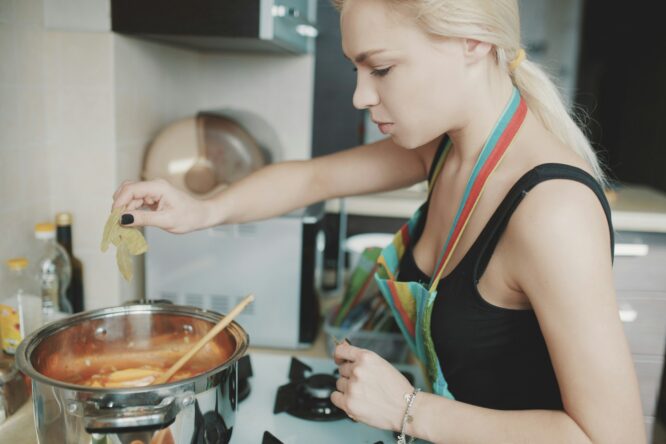
Some of the most sensible money habits aren’t new — they’re just forgotten. Our grandparents knew how to stretch a meal, reuse what they had, and live well without splurging. And now, with the cost of just about everything going up and up, it might be time to dust off some of those old tricks. Doing these things doesn’t make you stingy or overly tight. Instead, they make you smart, resourceful, and a bit more intentional. Here are some old-fashioned frugal habits that actually deserve a comeback these days.
Making do and mending
Once upon a time, if something ripped, cracked, or wobbled, you fixed it. You didn’t chuck it straight in the bin. Whether it was sewing a torn shirt, gluing a chair leg, or reattaching a button, people had basic repair skills most of us have lost. Getting back into the habit of fixing instead of replacing can save hundreds over time. Plus, it’s satisfying in a way buying something new just isn’t.
Planning meals around what you already have
Before next-day delivery and food apps, people planned meals around what was in the cupboard, not the other way around. It meant less waste and fewer emergency trips to the shop. Even just one “use it up” meal a week makes a difference. It’s amazing how creative you get when you’ve got a tin of beans, a few sad-looking carrots, and a half-bag of rice.
Buying less, but better
Fast fashion and throwaway culture have made it normal to buy five versions of the same cheap thing. However, older generations often bought one decent version, and made it last. Investing in quality (when you can) usually works out cheaper in the long run. Whether it’s shoes, pans, or jackets, the cost per use beats having to replace flimsy stuff every year.
Reusing everything
Jars became storage, scrap paper became shopping lists, and worn-out clothes became cleaning rags. Nothing was “single use” unless it absolutely had to be. It’s not hoarding. It’s seeing value in things before binning them. That peanut butter jar doesn’t need to die after one use. It could be your new lunch container.

Walking wherever possible
Back then, walking wasn’t a wellness trend—it was just normal life. People thought nothing of walking to the shop, the post office, or their mate’s house. In 2025, it’s easy to default to Ubers or quick drives. However, walking saves money, clears your head, and adds movement to your day without even thinking about it.
Hanging washing out to dry
Clothes dryers are convenient, but they eat up electricity, and wear out your clothes faster. Before tumble dryers were common, people hung clothes out, inside or out, and let time do the job. Drying racks, airers, or even a basic clothesline can save you a chunk on your energy bill, especially if you’ve got a household that never stops doing laundry.
Cooking from scratch
Even in the busiest households, someone found the time to make a proper meal. Ready meals were rare, and eating out was a treat, not a default. Cooking doesn’t have to mean gourmet. Simple soups, stews, and traybakes are cheap, healthy, and usually tastier than anything that comes pre-packaged in plastic.
Growing your own food (even just a bit)
You don’t need a massive garden to get in on this. Back in the day, people grew herbs in windows, tomatoes in pots, and potatoes in buckets—wherever there was a bit of sun and soil. Growing a few edible bits at home not only saves a bit of money, it also connects you to your food in a really satisfying way. Plus, nothing beats snipping your own herbs for dinner.

Batch cooking and freezing
Families used to cook double portions and freeze the rest without calling it “meal prep.” It was just practical. It meant fewer nights of panicking about what’s for tea. Making big batches of things like soup, curry, or pasta sauce means you’re covered on the nights when cooking feels like too much, and you’re not reaching for takeaway again.
Using cash for everyday spending
In a contactless world, it’s ridiculously easy to overspend without noticing. People used to take out a set amount of cash each week and make it stretch because once it was gone, it was gone. Even now, using physical cash for things like food shops or petrol can keep spending more visible. There’s something about handing over a tenner that hits different to just tapping.
Learning skills from each other
Communities once relied on swapping skills. One neighbour knew how to sew, another could paint, someone else fixed radios. People didn’t pay out for every little task—they asked around. Whether it’s fixing a bike, cutting hair, or teaching someone to use Excel, reviving that community swap-and-share mindset could cut costs and build better connections too.
Avoiding impulse buying by sleeping on it
If something caught your eye in the catalogue or shop window, you didn’t always buy it straight away. You went home. Thought about it. Sometimes came back. Sometimes didn’t. Slowing down the purchase process helps you realise which things are wants and which are just fleeting distractions. Waiting 24 hours might save you hundreds over the year.
Passing things down
From clothes and prams to tools and furniture, hand-me-downs used to be normal. Things had a story. They were built to last and worth keeping in the family. In 2025, second-hand is back in fashion, but going one step further and actively reusing things across generations? That’s where the real savings (and meaning) happen.

Using public libraries
Need books, films, internet, a printer, or a quiet workspace? The library’s got you. People used to visit as part of everyday life, not just when they couldn’t afford alternatives. They’re free, they’re underused, and they’re one of the last truly communal resources. It’s time we all made better use of them before they disappear completely.
Valuing what you already own
This is the heart of old-school frugality: not chasing more, but being content with enough. People wore the same coat for years. They took care of what they had. They didn’t upgrade things just because a new version came out. It’s not about going full minimalist. It’s about remembering that satisfaction doesn’t always come from the next purchase. Sometimes it comes from appreciating what you’ve already got.




